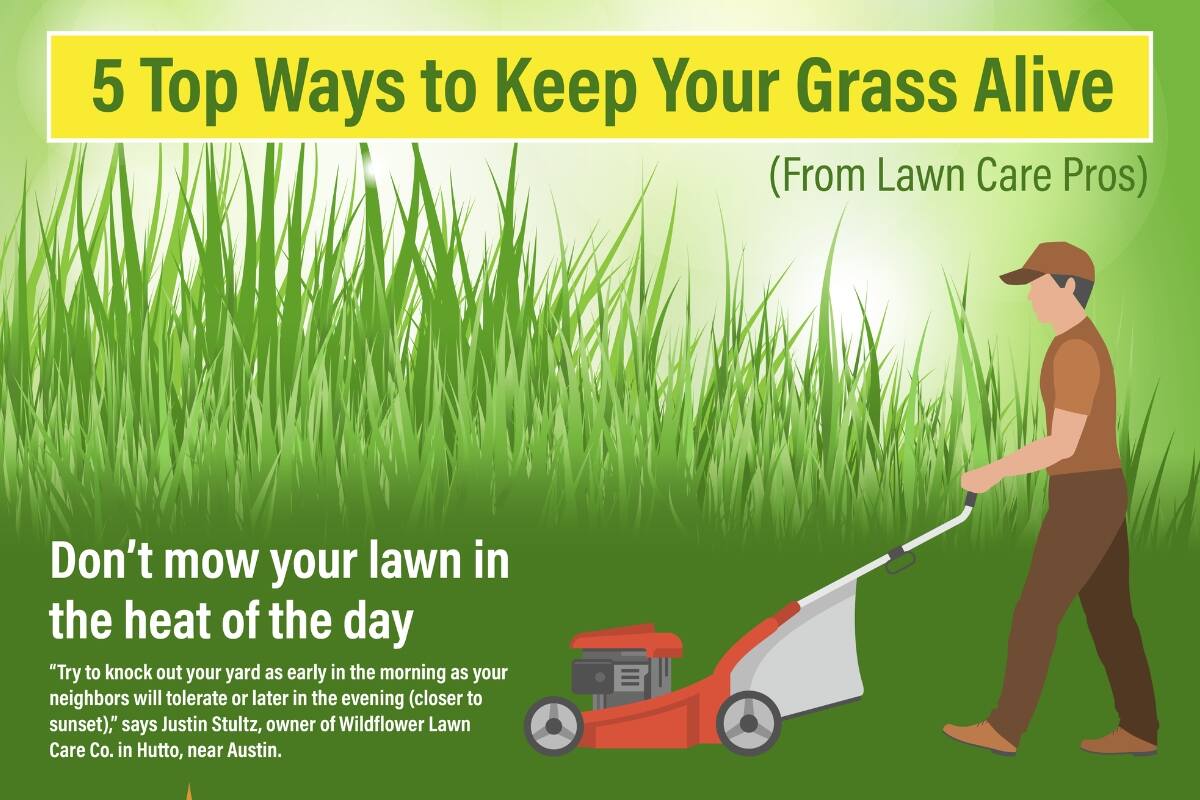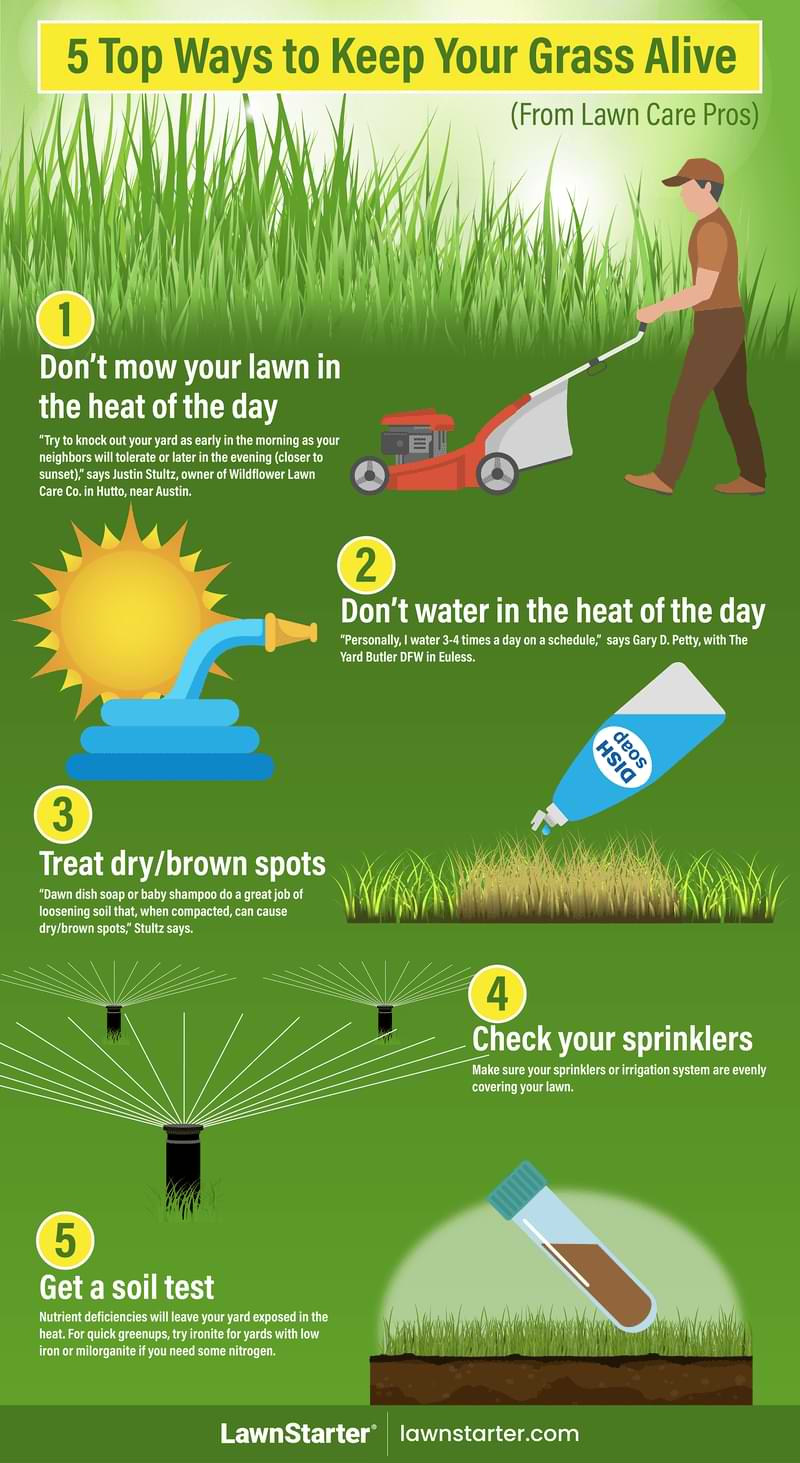
As 100-plus-degree temperatures continue to bake Texas, your green, green grass of home likely is turning yellow and brittle. How to keep your grass alive in record heat? We asked a couple of LawnStarter pros for their tips.
After all, our Texas lawn mowing pros aren’t just mowing your grass or your neighbor’s, but they have to brave this same brutal heat to keep their own lawns looking trim and sharp. So their 9 tips – and 1 from us – can help you care for your grass wherever you live in the Lone Star State.

1. Don’t mow in the heat of the day
“Try to knock out your yard as early in the morning as your neighbors will tolerate or later in the evening (closer to sunset),” says Justin Stultz, owner of Wildflower Lawn Care Co. in Hutto, near Austin.
2. Don’t water in the heat of the day
“Personally, I water 3-4 times a day on a schedule,” says Gary D. Petty, with The Yard Butler DFW in Euless. (This is easy to do with a sprinkler or irrigation system on a timer):
– 6:30 a.m. for 15-20 minutes
– 10 a.m. for 10-15 minutes
– 8:30 p.m. for 20-25 minutes
– 2 a.m. for 10-15 minutes
Watering times vary due to soil type. If you have condensed clay or sandy soil types, decrease time by 5-8 minutes, Petty says.
Note: Always follow your town’s water restriction regulations/laws.
Petty, who has been in the lawn care business since 1998, noted that there will likely be many different answers when it comes to watering, and Stultz offers his take below.
3. Water early and let it soak
“Watering early will keep as much moisture from evaporating in the heat as possible,” Stultz says. “And watering for longer durations, less frequently, will cause the root system to grow deeper because it will become acclimated to accessing moisture from deeper in your soil.”
4. Don’t fry your grass
Never apply fertilizer or massive amounts of nutrients during the summer season, “especially during peak heat times,” Petty says. “It will fry your grass.”
When is the best time to fertilize your Texas lawn? “Typically the majority of your nutrient building and fertilization should take place in the fall, essentially preparing for winter, and in spring, to prepare for summer,” he adds.
5. Treat dry/brown spots
“Dawn dish soap or baby shampoo do a great job of loosening soil that, when compacted, can cause dry/brown spots,” Stultz says.
Other possible causes of brown spots in your yard include poor pH levels, thatch buildup, fungal diseases, animal waste, and lawn pests.
6. Check your sprinklers
Do a sprinkler audit to make sure your irrigation system is evenly covering your lawn. “If you notice certain areas having difficulty staying green, leave an empty tuna can in the dry area overnight or for a watering cycle and see how much water the area is getting compared to greener spots,” Stultz says.
What to look for in the tuna can test: You want your grass to get 1 inch of water. Less than an inch of water in the tuna can means your grass could use more water. More than an inch and you should cut back on the duration of your watering.
7. Combat lawn pests
“Remember to defend against bugs and pests in spring and again in midsummer, regardless of temperatures,” Petty says.
Common summer lawn pests include grubs, fire ants, chiggers, chinch bugs, armyworms, cutworms, and mole crickets
“For example, the presence of grubs will turn your lawn yellow as well. And an unhealthy lawn can’t defend itself if it’s being attacked by lawn pests,” he adds.
How to get rid of grubs in your lawn? Apply a curative pesticide in late summer after the eggs have hatched, or try beneficial nematodes, but know the grub you are battling as certain nematodes attack particular types of grubs.
8. Get a soil test
Why should you get a soil test? Nutrient deficiencies will leave your yard exposed in the heat. For quick greenups, try ironite for yards with low iron or milorganite if you need some nitrogen, Stultz says. Liquid foliar applications (on leaves of grass, not the soil) in the evening should deliver nutrients with plenty of time to dry before the next day’s heat.
Of course, make sure you are following usage instructions for quantity and frequency of use.
9. Tip for next year? Aerate your lawn
Aerate your Texas lawn in early spring so your grass can better weather the heat. What is aeration? Over time, soil becomes compacted. This makes it difficult for water, air, and nutrients to penetrate the soil.
Core aeration is basically the process of pulling up little dirt plugs out of your lawn to relieve this pressure.
“Aeration helps open up your top layer of soil, so that proper water absorption can take place,” Petty says. “It allows your lawn to optimize the sedimentation rate, as well as providing proper oxygenation to the root.
“With proper preparation in spring, and with watering more often and in shorter durations, it is very possible to keep your lawn healthy,” Petty says.
10. Hire a lawn care pro to care for your lawn in the heat
If you’d rather not sweat pushing or riding your lawn mower and wielding a string trimmer, hire a LawnStarter lawn care pro. They’re used to working in the sun and have their own tricks to help them beat the heat.
What is LawnStarter?
Austin-based LawnStarter makes it easy to book lawn care and other outdoor services with vetted pros near you. Our platform also helps lawn care pros to mow more lawns near where they live so they earn more money and spend less time and gas driving from job to job.
LawnStarter has over 5,640 active lawn care pros across Texas, and LawnStarter operates in more than 120 metro areas across the U.S.
“I hope these quick tips will help some folks out this summer!” Stultz says.
Main Photo Credit: Infographic by Juan Rodriguez